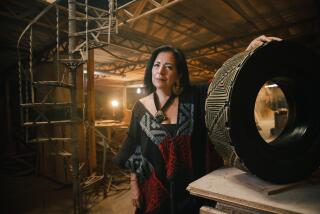A BOUNTY OF MEXICAN ART AND FOLK ART
- Share via
Donald Cordry and Dorothy Mann of Minneapolis loved the same things: Mexican culture and each other. When the couple married and moved to Mexico in 1937, a lifetime of collecting Mexican art and folk art together began.
Fifty years later, the results of the Cordry’s efforts are on exhibit at UCLA’s Museum of Cultural History. “Mexican Art and Folk Art from the Cordry Collection” is composed of 100 objects including five 19th-Century paintings, colonial Mexican furniture, and animated ceremonial masks, primitive dolls and colorful hand woven garments from this century made by various Mexican Indians.
“As art students in Minneapolis, the Cordrys took a school trip to Mexico in 1931,” said museum curator Patricia Altman at the on-campus gallery the other day. “He fell irrevocably in love with the country and she did too. They went back home of course, both moved to New York, and he became a puppeteer,” later touring the country with a professional troupe.
“But Donald couldn’t get Mexico out of his mind, and talked the Museum of the American Indian in New York into sending him back on a six-month collecting trip. He went to Guerrero, Michoacan and Jalisco, all in Central Mexico, traveling on burro into remote areas that had no roads, no nothing, and acquired objects, mostly costumes (native dress), from the Indians living there.
“But that didn’t cure him at all,” said Altman, describing Donald Cordry as an “intrepid explorer.” “He came back to New York, married Dorothy, and they promptly moved to Mexico in 1937 where they stayed forever.”
Donald Cordry, who died in 1978, continued collecting for museums in America and Mexico, Altman said, gathering objects throughout Mexico from such Indian peoples as the Otomi and Mayo. He also designed works in silver, gold, and other materials, and ran a studio for other artisans to do the same.
Dorothy Cordry, now 85 and living in Mexico, Altman said, kept records of the couple’s collection of which the Museum of Cultural History now owns about 1,000 pieces.
Altman, a friend of the Cordry’s, met Donald 35 years ago when he came into her ethnic and folk art shop on La Cienega Boulevard.
“We made a trade,” said Altman, who ran the shop for 18 years before volunteering at the Museum of Cultural History in 1967 to assist its first director, her husband Ralph C. Altman. “Donald gave me four Mexican dolls for a Siamese puppet.”
Three other puppets, a clown, a bird and a ghost marionette made and used by Donald Cordry, are also displayed in the exhibit, which runs through Aug. 30.
“I couldn’t resist including these, but I love the nun painting better than anything in this room,” said Altman, referring to an anonymous 1886 oil portrait of a Sister Maria Monica.
The imperious but beleaguered 73-year-old nun is dressed as she was, with an elaborate pink, purple and white floral headdress, on the 50th anniversary of the day she was accepted into the convent.
“The idea of owning this painting is delirious,” Altman said. “I never thought the Mexican government would let it out of the country. But the minute I saw Sister Maria Monica, I loved her. Mexican monasteries were dissolved in the 1850s and the nuns were sent to private homes to live out their lives. She has a face of character and determination, I’m sure formed by the fact that for 30 years she lived in strange conditions outside of the convent--strange because unless they married, all women at that time lived in nunneries.”
The Cordrys also gave the museum nearly 4,000 books, many of them rare volumes on the art and folk art of Mexico. Also donated were books by Donald Cordry, an ethnologist without academic training who recorded in text and photographs the lives, ceremonies and dress of Mexican peoples.
These books, as the rest of the Cordry’s acquisitions, will be used for study, Altman said.
“I’m sure that’s partly why Dorothy chose to give us the collection. We’ll make it available for students and scholars, as well as exhibit and care for it.”
More to Read
Sign up for Essential California
The most important California stories and recommendations in your inbox every morning.
You may occasionally receive promotional content from the Los Angeles Times.













![Vista, California-Apri 2, 2025-Hours after undergoing dental surgery a 9-year-old girl was found unresponsive in her home, officials are investigating what caused her death. On March 18, Silvanna Moreno was placed under anesthesia for a dental surgery at Dreamtime Dentistry, a dental facility that "strive[s] to be the premier office for sedation dentistry in Vitsa, CA. (Google Maps)](https://ca-times.brightspotcdn.com/dims4/default/07a58b2/2147483647/strip/true/crop/2016x1344+29+0/resize/840x560!/quality/75/?url=https%3A%2F%2Fcalifornia-times-brightspot.s3.amazonaws.com%2F78%2Ffd%2F9bbf9b62489fa209f9c67df2e472%2Fla-me-dreamtime-dentist-01.jpg)